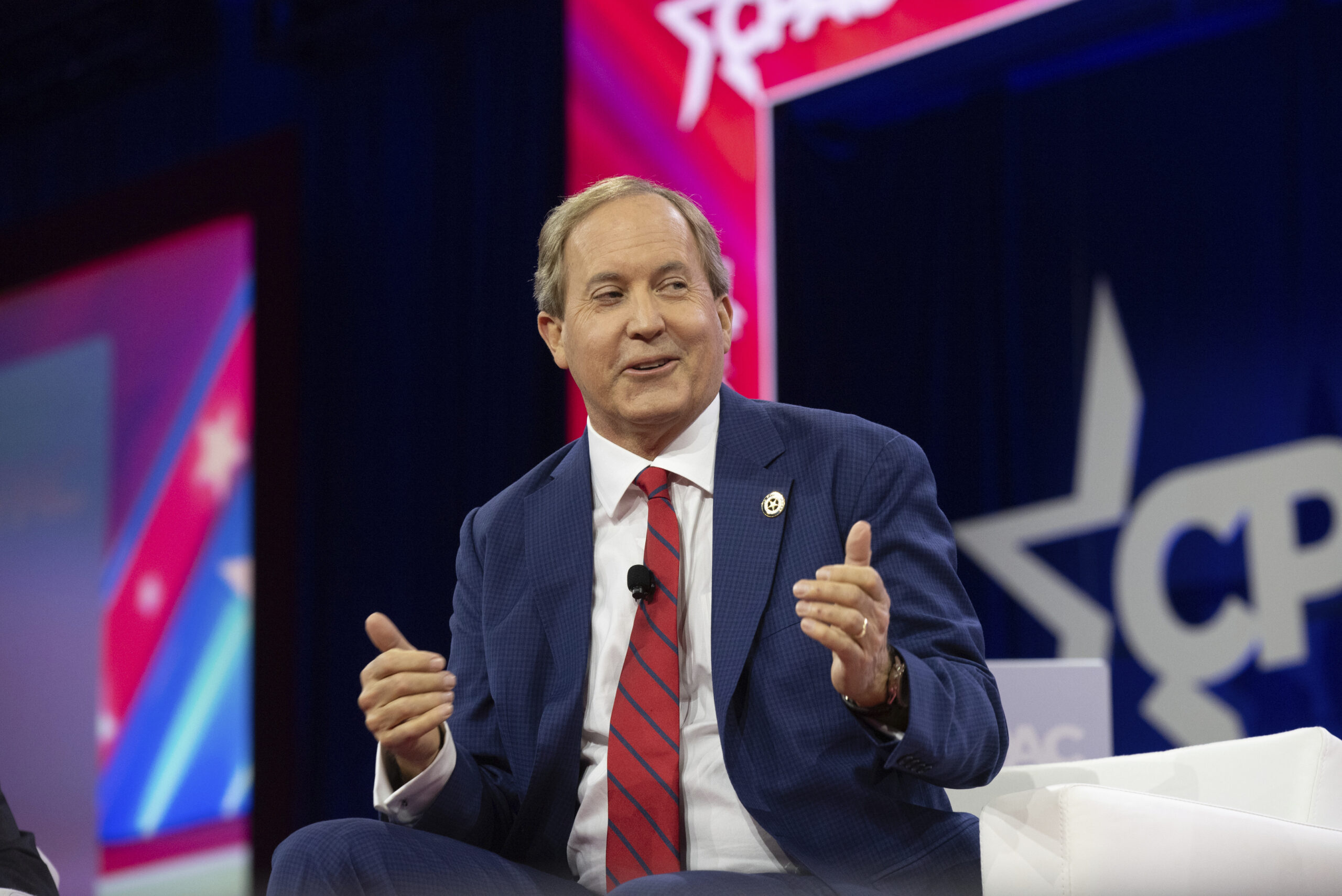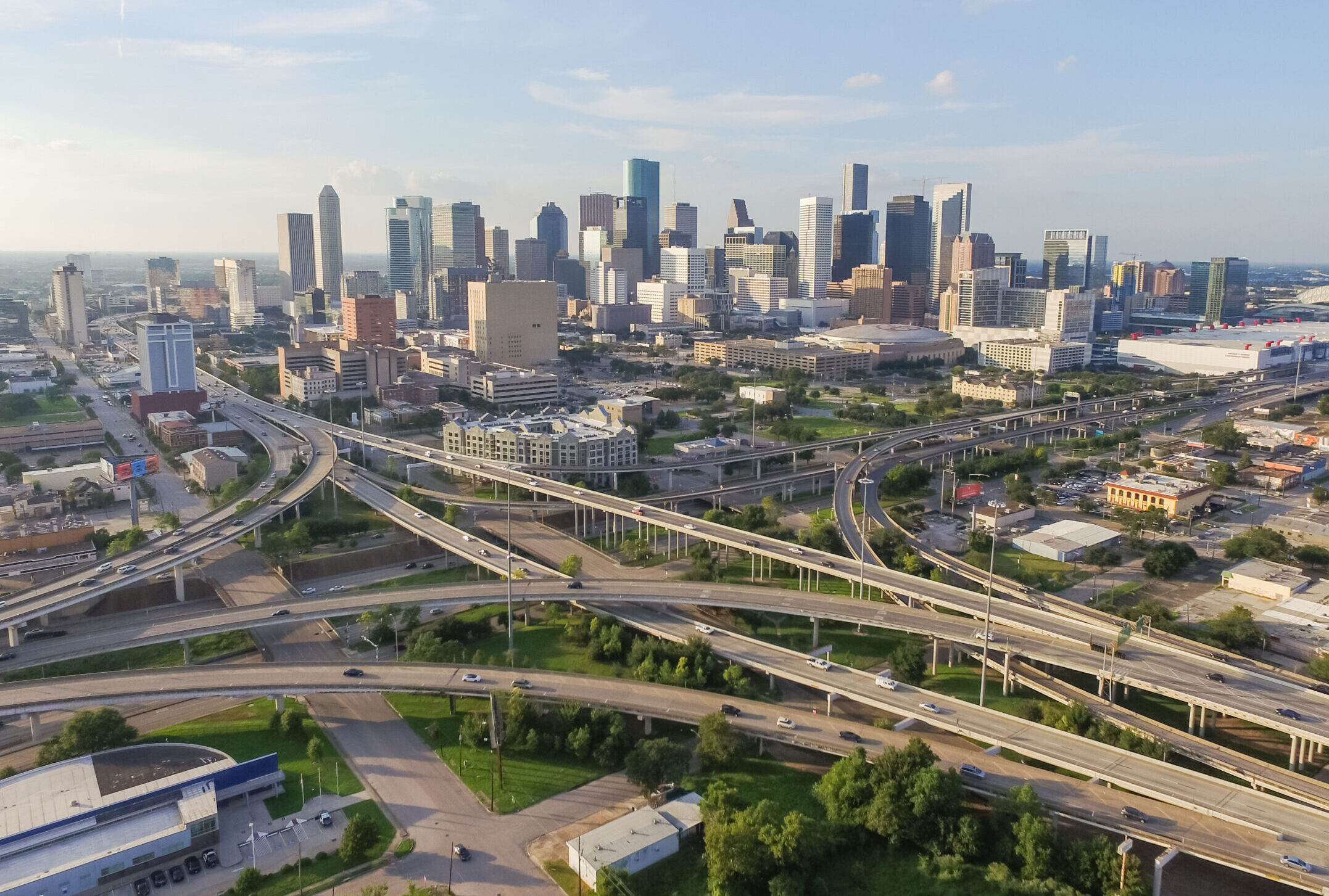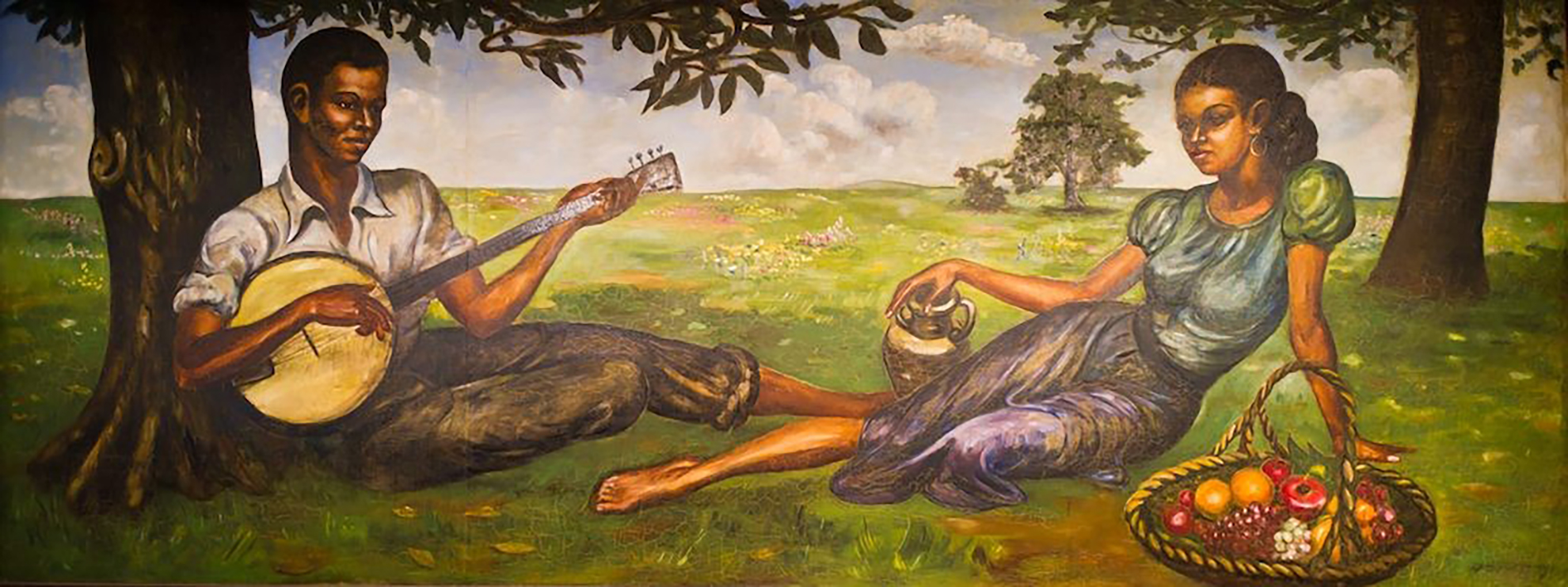
Beyoncé Isn’t Possible Without Houston. Houston Isn’t Possible Without the Black Diaspora.
Texas’ artistic innovation is nothing new and continues to be center stage through artists like Beyoncé during yet another period of Black rediscovery.
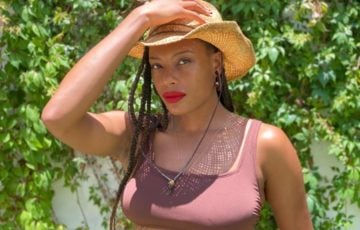
Above: Staff Sergeant Samuel Countee’s World War II era mural.
Beyoncé’s second visual album, Lemonade, is characterized by foreboding visions of weeping willows, dark bayous, and images of Black women decorated in antebellum garb. It’s an ode to the landscape of Texas and Louisiana and heavily inspired by the 1991 film Daughters of the Dust. Lemonade, a 12-song visual, takes the viewer through a folkloric story of love, loss, forgiveness, and growth while centering Black feminine power and unity. It’s also an ode to her home and her roots.
A Houston native, Beyoncé identifies as a Creole Afro-Texan: a mixture of West African, Mexican, Indigenous, Spanish, and French heritage, exemplifying the region’s convergence of cultures. This heritage can also be heard in songs like “Daddy Lessons” which merges New Orleans jazz with Texas country music through a confetti of brass trombones, trumpets, saxophones, and tambourines. Beyoncé, the artist’s first visual and fifth number-one album, focuses on her hometown and serves up a “jazz impulse of Houston’s past and present,” writes Tyina Steptoe, an associate professor at the University of Arizona. The album also includes a visual for her song “Blow,” which was filmed at the FunPlex Amusement Park, a childhood landmark for the artist and a staple in Houston.
Now, her most recent visual album, Black is King, released this year, explores a diaspora and encourages yet another period of rediscovery for Black people, this time with an even farther, global reach, rooted in her ideas of home. The film is a companion to her album Lion King: The Gift which was released last year.
Beyoncé’s work and artistic expression, grounded in Houston and the South, is no random phenomenon. The global star is loved yet controversial due in part to her increased pro-Black stance alongside her palatable Creole features which play into colorism tropes, yet she is arguably one of the most influential icons of our lifetimes. Her complexity and work should be seen as a representation of Texas’ Black artistic heritage, and her vision a result of the “artistic Eden” that is Houston—a city tilled by expressive and innovative Afro-Texans during the New Negro Movement in the 1920s and 1930s, whose artistry continues to reverberate throughout Beyoncé’s work as well as that of Black artists across the state.
Beyoncé “takes the viewers on a slab ride through the oldest and Blackest spaces in her hometown,” writes Steptoe, who has extensively studied race and culture in Houston. In Beyoncé, the video for “No Angel” features Beyoncé posing in all white with a cowboy hat as she stands in front of a traditional shotgun-style house found in the older parts of Houston. Images of the Fourth Ward, a historic African American community in the Bayou City, move across the screen: candy red slabs, OG rappers, and a strip club locker room. The video also includes a shot of Cuney Homes, the Third Ward’s first public housing complex, named for Norris Wright Cuney, an African American activist during Reconstruction.
“When I’m connected to something I immediately see a visual or a series of images that are tied to a feeling or an emotion,” said Beyoncé in an interview about the album. “A memory from my childhood, thoughts about life, my feelings or my fantasies.”
Beyoncé grew up in Houston’s Third Ward, but her lineage spans the deep South. At the turn of the century, her relatives migrated to a Creole Freedman settlement in Texas known as Frenchtown, now the northern Fifth Ward in Houston. The Freedman town was a Black, French-speaking, Catholic settlement that brought what was then called LaLa music—now known as Zydeco—to the area. Her work reverberates with her upbringing, in Texas and the South, as well as the region’s history of music, activism, and sense of community.
“As she’s finding herself she’s encouraging you to come along,” said Kinitra Brooks, an associate professor at Michigan State University and the co-author of The Lemonade Reader. “Her talent is being able to tap into the cultural zeitgeist.”
In the early 1900s, as the Great Migration shifted the country’s demographics, charged political, social, and artistic expression converged in New York, spawning the New Negro Movement, known as the Harlem Renaissance. There was a new sense of racial pride, expression, and economic independence.
Like a Harlem gusher, art flowed out of Black communities and the boom could be felt all the way to Texas, which was still mostly rural at the time. Slavery from the antebellum period still stained the state, but Dallas, Houston, San Antonio, and El Paso were hailed as Black cultural havens. Houston’s population almost tripled between 1915 to 1930, making it the largest urbanized area in the South and among the largest in the nation. More than 60,000 Black people, mostly from rural East Texas and Louisiana, occupied the city’s middle-class Third Ward, commercial and cultural Fourth Ward, and working-class Fifth Ward. This massive shift would take place between WWI and WWII due to the 1927 Mississippi Flood—the most destructive flood in American history which displaced hundreds of thousands African Americans.
At the time Houston, like the rest of the state, saw heightened moments of racial violence, but it was art that would solidify “the spiritual union between Black autonomy and talent, with the latter becoming the means to ending African American injustice,” wrote Bernadette Pruitt in The Other Great Migration: The Movement of Rural African Americans to Houston, 1900-1941. Pruitt, a professor at Sam Houston University, says that Houston’s cultural awareness defined the city during this period of Black rediscovery, as literature, music, art, photography, athletics, and satire bridged divides and used performance as protest.
Houston’s Renaissance began around the 1930s with the emergence of Navasota-born jazz player Milton Larkin, pianist Victoria Spivey, and pianist and composer Beulah “Sippie” Wallace. Visits from big names like Langston Hughes and Cab Calloway would bolster support for the arts in Houston and around the state. In 1930, the Houston Museum for Fine Arts held the first major Black traveling exhibitions in the country. It included works from Marshall-born Samuel Countee, who moved to Fourth Ward as a child and was later featured in the Hall of Negro Life at the Texas Centennial in Dallas in 1936. Some of his most notable paintings include “My Guitar,” “Little Brown Boy” and a mural depicting a Black man and woman picnicking which has been compared to Adam and Eve in the Garden of Eden.
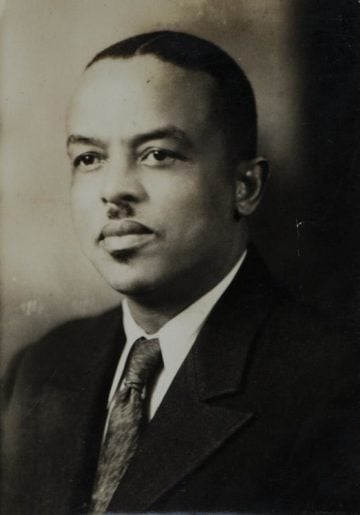
Simeon B. Williamson became known for his satirical columns in Houston’s historic African American newspaper, The Informer.
Photographers like Enoral and Arthur Chester Teal challenged stereotypical images of African Americans, while spaces like Eldorado Ballroom in Third Ward and Bronze Peacock in Fifth Ward were popular night spots that broke color barriers by providing entertainment to integrated audiences.
Art was able to thrive in Houston’s tight-knit Black communities, which were bolstered by Historically Black Colleges and Universities (HBCUs) like Prairie View A&M University and Texas Southern University. They were also tied to Black fraternity and sorority organizations like Delta Sigma Theta Sorority, Inc., Alpha Kappa Alpha Sorority, Inc., and Zeta Phi Beta Sorority. Houston’s Black women also created a thriving community embedded in charity work and activism through organizations like the Houston Foundation, now the United Way, the Blue Triangle YWCA, and more. Models of giving still practiced by Beyoncé today through her BeyGOOD foundation, Homecoming Scholars Award Program, as well as support for coronavirus testing in both the Third and Fifth Wards of Houston.
The rest of Texas followed. Dallas’ art scene, which was dominated by white bankers and realtors, would become a space in which Black writers like Lilian B. Jones Horace, an avid Marcus Garvey follower, could debate politics through poetry or short stories. Central Texas would give birth to musicians like Eddie Durham, one of the most important composers and arrangers during the Swing Era. Ernestine Tanner, a Black painter from Seguin, would depict juke joints through her paintings. San Antonio would serve as a prominent hub for the Chitlin Circuit and a place where Black recordings could come alive on records.
This history, and the legacy of these pioneering Texas artists, continues to inform and inspire Beyoncé’s work.
The opening lines of “Black Parade,” the last visual song on Black is King, are “I’m going back to the South/I’m going back, back, back, back/where my roots aren’t watered down.” Here, Beyoncé points directly at her Southern roots, turning specifically toward Texas. She dropped the song on Juneteenth, a celebration created by formerly enslaved Black Texans. With its bouncy Afrobeats and trap over brassy undertones floating alongside a melodic flute, the song injects lyrics that feel specifically tailored to be a soundtrack to a summer made even more intense by a global uprising: “Rubber bullets bouncin’ off me/Made a picket sign off your picket fence/Take it as a warning.” This isn’t the first time Beyoncé has used her platform to ignite Black Pride.
“[The world is] recognizing not just the Southern roots of people that have come before us, but that creativity is still in the South, has always been in the South, and will always be in the South,” said Kinitra Brooks, an associate at Michigan State who looks at Black women in pop culture. “It’s such a fertile space for the creativity that we’re seeing on such a prodigious level right now.”
In 2018, Beyoncé performed at Coachella, the first time an African American woman headlined the music and arts festival. Homecoming was a gumbo pot filled with diced and chopped versions of some of Beyoncé’s most noteworthy songs. The performance, which lasted more than an hour-and-a-half, included a rendition of the Black national anthem, “Lift Every Voice and Sing,” which is commonly played and sung at HBCUs, churches, and protests. Beyoncé and dancers paraded in sorority-like jerseys mixed with drill team uniforms, berets, and boots reminiscent of the Black Panther Party. It’s a celebration of Black American and Southern identity in its contemporary form as well as a reflection of the historic culture cultivated in her hometown of Houston.
Black is King, the visual album, is a creative ode to the Black diaspora; Homecoming speaks to a sense of community; Lemonade is an homage to her Black Southern identity; and her self-titled album is a reminder that her inspiration is homegrown. Yes, Beyoncé’s legacy will be forever lasting, but it can’t be forgotten that those talents were inspired and supported by a motherland of Southern, Black autonomy which also saw a cultural shift with the rest of the country almost a century before. As the world sees yet another shift in ideology and demographics, so will the state of Texas—and artists will continue to capture the moment in real time and represent the very heritage that influenced them.
Read more from the Observer:
-
Why Does John Cornyn Tweet?: An analysis.
-
A Monumental Undertaking: Protests to remove racist statues and iconography are part of a larger effort to reframe Texas history.
-
New Engineering Report Finds Privately Built Border Wall Will Fail: The report confirms reporting from ProPublica and the Texas Tribune that found portions of the wall were in danger of overturning if not fixed due to extensive erosion just months after it was built.
